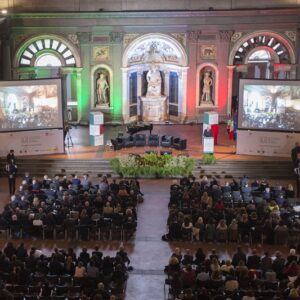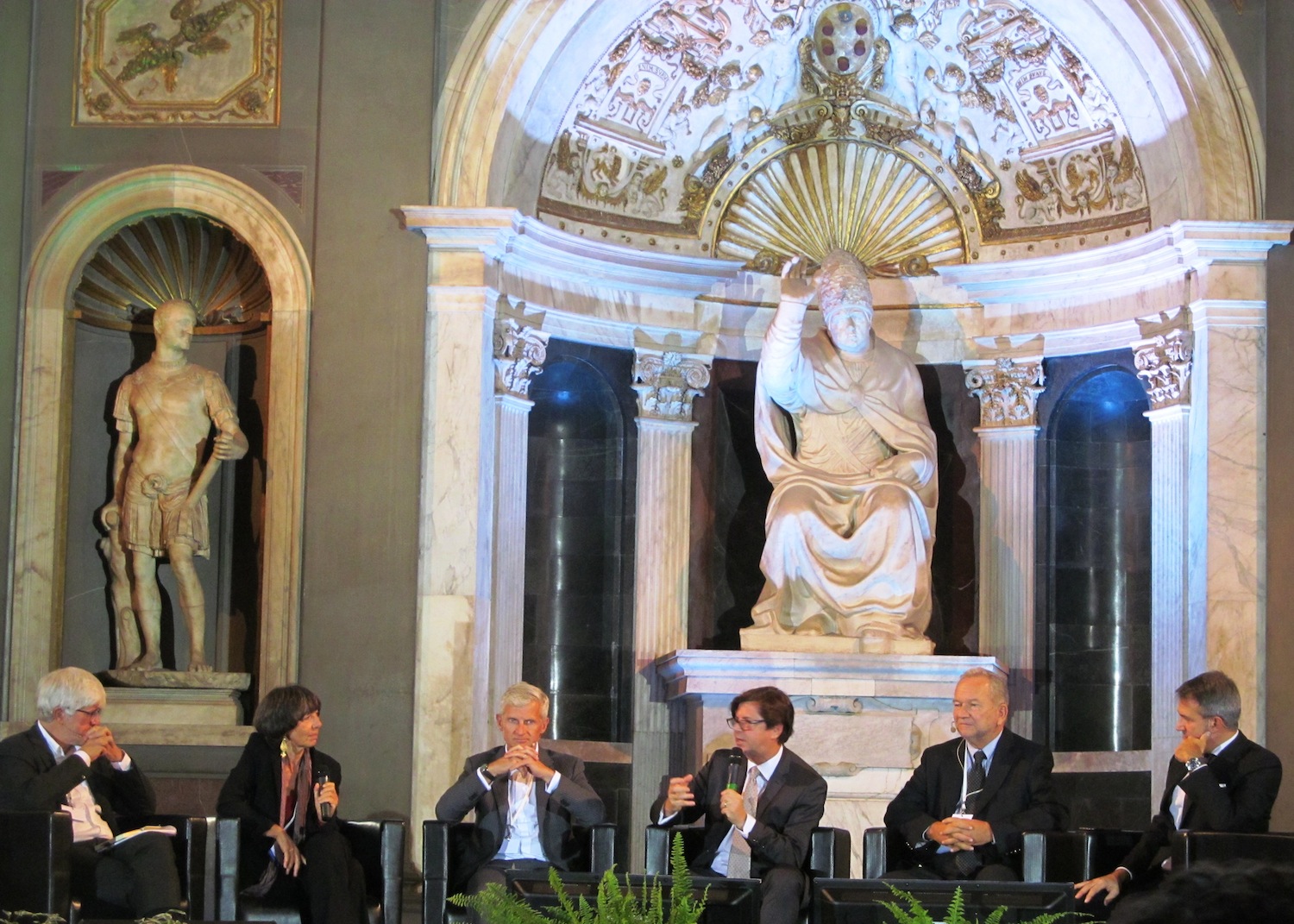LEGGI QUESTO ARTICOLO IN ITALIANO

As the 16th installment of the Week of the Italian Language in the World comes to an end, I wish to share a few reflections on the second edition of the Joint Action for the Italian Language in the World at Palazzo Vecchio on October 17-18, which coincided with the start of this week dedicated to Italian. I “attended” a number of sessions that were streamed live and subsequently watched post-conference archived sessions. This conference was a feast for the eyes and soul of Italian culture, whetting our appetite for the implementation of new initiatives worldwide, and feeding our hunger for Italian design and creativity. Even from afar, the speakers, presentations and round tables were very engaging, and the public figures—from the opening with Prime Minister Matteo Renzi to the closing ceremonies with President of the Republic Sergio Mattarella; as well as some of the finest minds of academia and the arts, media, business, and government—provided much food for thought.
Bound together by a common spirit, sharing in a common endeavor, the two days of talks focused on the five working groups (italophony, internationalization of universities, technology use, certification, creativity). It would be impossible to adequately summarize all the data, ideas, and proposals and projects underway, so I’ve opted to comment on some concepts that were highlighted by speakers that I consider pertinent to teaching of Italian in American universities.
“Of course Italian is a living language!”
This response given by Andrea Illy about the title of the conference, Italian, Living Language, quickly launched the debate. Identifying it as a “living language” was no challenge to panelists during the first round table, moderated by Beppe Severgnini, journalist and essayist. Prior to the start of this session, Severgnini advised participants there would be a euro fine a for each non-Italian word uttered during the conference, and he had already started keeping tabs from the opening ceremonies.

This round table on the use of Italian in communication strategies included representatives of Fiat Chrysler (Olivier François), the Altagamma Foundation/Illy Coffee (Andrea Illy), San Pellegrino (Clemént Vachon) and Bulgari (Lelio Gavazza), and communications expert Annamaria Testa. When Severgnini asked Illy his thoughts on the title of the Joint Action conference, Illy respectfully replied that he would have marketed the conference differently, as “Italian, Loved Language.” Love here is not only the love of courtship and seduction generally associated with Italian, but also the love of family and friends. This was instantaneously embraced by conference participants, changing the conference title, unofficially, to “Italian, Living and Loved Language.”
Severgnini added to Illy’s remarks that Italian, Living Language could make one think that, in reality, it could not be a living language but an ancient one. It was precisely this reaction that I too had, making associations with the Latin textbook series, Lingua viva, published by Mondadori, as well as the annual Living Latin conference, hosted by the Paidea Institute and Fordham University, which allows teachers and students of Latin to practice the active (spoken) use of Latin. Drawing further analogies, Italian and Latin share a lexical similarity that makes Italian the closest successor of Latin. The title may in fact have involuntarily suggested, to some degree, a dead language, and may prompt the question: “Does Italian already have a foot in the grave?” The response: Not on your life.
We ♥ Italian
“Italian is the quintessence of ‘cool’ – declared Illy, an English word for which he gladly paid the fine – and being cool is one of the key ingredients for being loved. If we started to collect measurable data of a love of Italian right now by searching the Internet, we would be quite gratified.” This should therefore translate well for Italian, both in terms of economics and the study of it. And in fact for the latter it has, as was confirmed by Deputy Foreign Minister Mario Giro providing current data in his opening remarks. “Foreigners who are studying Italian around the world are now 2.3 million. Two years ago they were 1.5 million. – Giro stated – The constant growth in interest for our language worldwide represents a fantastic factor for projecting the image of Italy, enhancing its economic, cultural appeal abroad, also as a tourism destination.”
The image of Italy is manifested through its language, stated Lelio Gavazza of Bulgari: “Italy breathes the beauty of its country. When we speak the language we succeed in imagining in a single utterance or a single sentence the meaning to the whole word that represents all that is Italian: all the beautiful works of art, all the sensuality that Italian people breath daily.” The Italian language is sexy. It is beautiful. It is contemporary. As President Mattarella declared in his closing remarks, Italian reflects modernity, innovation, a global economy. Evidence of this success, of a living and loved language, was encapsulated by two Fiat spots that use Italian exclusively. The first aired during the during Super Bowl XLVI in 2012, and piqued such curiosity for the Italian language that Google searches for “Che cosa guardi?” after it aired ranked above all other searches. The Italian language can achieve new heights if Italians, Italophones, and italici are willing to reclaim the language they have, for the most part, abandoned.
America, Economics and Education
What resonated from the communication strategies round table to the subsequent sessions was a greater understanding by this writer of the international presence of Italian and areas that are poised for growth because of a love of Italian. Foreign Minister Paolo Gentiloni declared in an interview given to Il Messaggero: “The second-largest group, which is quickly climbing up the ranking, is the category of foreigners who do not have ‘blood ties’ but are interested in the Italian language either for professional reasons, for geographic proximity, or because they feel the appeal of the Italian culture in general (art, music, design, cuisine…).”
These groups include Chinese students and Peruvians. In the round table with Fiat, Bulgari, Illy and San Pellegrino, we learned upcoming markets that love Italian include the Asian market and also the French. The session on the findings of different pilot projects of the 2014 edition of the Joint Action highlighted investments in China, the Mediterranean, Northern Africa and the Balkans. So where does America appear in programs of the Joint Action? According to the research conducted by the Ministry, Gentiloni reminds us that “the highest numbers of Italian students are from historical destination countries for Italian migrants: Germany, France, Australia, USA, Argentina.”

Silvana Mangione, vice secretary general of CGIE (General Council for Italians Abroad), was preselected to represent the U.S. during the segment dedicated to the live participation of audience members and chat contributions from abroad. Mangione articulated a number of recommendations to better position the promotion and teaching of Italian in the U.S. including, an appeal to institute the teaching of Italian at elementary schools to feed future university programs; a recognition of diverse teaching techniques and strategies without imposing a single teaching model internationally; a continued investment in e-learning; and to develop and support managing bodies rooted in different American territories to expand Italian programs nationally.
From the perspective of a university professor, recommendations to increase support to the U.S. market are essential for the survival and expansion of programs in the teaching of Italian language and culture. If we recall the words of the Minister of Education, Stefania Giannini, during her most recent trip to New York, she is very concerned about emerging trends in academia in the U.S. that have seen cuts to Humanities programs, which are however fundamental to education. Clearly, the promotion of this loved language must be supported by the Italian government and its agencies and institutions—dare I suggest even businesses—to work closely and collaboratively with American education systems at all levels. We can develop these enriching collaborations implementing a bottom-up approach, recognizing the needs of our American reality and developing them cooperatively.
Next, it behooves me to also speak to an American reality that often may not be fully appreciated with respect to the teaching of Italian: the students. It is true that relatively speaking the number of students studying in the U.S. is significant, and this is owing to, as Gentiloni indicated, Italian migration. However enrollment patterns in Italian programs at the university level have indicated a decrease of over 11% over the last five years, according to the most recent Modern Language Association report (see the table on page 2 of the press release). Also worth noting is the direct correlation between students of Italian to cultural heritage decreases with each cohort. Currently, we find our classrooms populated with non-heritage students who love Italy and all things Italian, in particular the “rich, lively, fresh, fragrant, and wanted” sound of Italian (awakening the senses, as described by Annamaria Testa, communications expert). Demographics of students of Italian are identifying them more in the category of the second-largest groups described by Gentiloni. They are Italian by choice and as educators we must be more cognizant of this distinction.
Finally, Italian educators in the U.S. would benefit from involvement in professional development opportunities as envisioned by the first edition of the Joint Action 2014, developed and elaborated at Ca’ Foscari University, and reported on by Paolo Balboni at this edition. The value of this professional development opportunity (offered fully online) – piloted in Northern Africa, the Balkans, the Middle East and China – was, in my opinion, the interdisciplinary curriculum development which comprises four modules. In addition to an updated look at the cultural richness of Italian Humanism through a contemporary lens, this pilot project also advances a module in non-humanities program, i.e., disciplines like engineering, architecture, and economics. Interdisciplinary connections are irrefutably the direction for all programs of study, thus training teachers to help break down academic silos and guide students to make connections between languages, cultures, and other non-traditional disciplines. May these opportunities soon be available to Italian educators everywhere.
My reflections are in no way meant to be exhaustive nor are they a representative statement on the status of the Italian language in America. My comments were provoked by engaging exchanges at this edition of the Joint Action for the Italian Language in the World conference, where I identified opportunities and challenges in the promotion of Italian language and culture that are worth pursuing.
LEGGI QUESTO ARTICOLO IN ITALIANO










